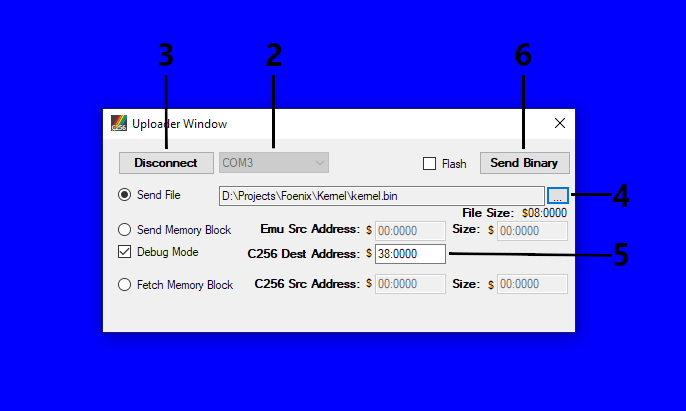Difference between revisions of "Using the Debug Interface"
(Copied from Low Level Development Tools) |
m |
||
| Line 1: | Line 1: | ||
| + | == Installing Drivers == | ||
| + | |||
| + | Data and programs can be sent to the C256 Foenix over the USB debug port (the USB port on the right side of the board, next to the expansion connector). | ||
| + | The debug interface is a USB serial port which requires a driver to be installed on the host system. The drivers for the serial USB device (XR21V1411) can be found at: https://www.maxlinear.com/support/design-tools/software-drivers. | ||
| + | |||
== Uploading with the Foenix IDE == | == Uploading with the Foenix IDE == | ||
Revision as of 15:11, 16 February 2020
Installing Drivers
Data and programs can be sent to the C256 Foenix over the USB debug port (the USB port on the right side of the board, next to the expansion connector). The debug interface is a USB serial port which requires a driver to be installed on the host system. The drivers for the serial USB device (XR21V1411) can be found at: https://www.maxlinear.com/support/design-tools/software-drivers.
Uploading with the Foenix IDE
To setup the Foenix IDE, not much is required beyond copying or cloning the repository from GitHub. There is no special installation required, and the EXE should just run.
To upload a BIN or HEX file with the Foenix IDE's user interface:
- Select the Tools > Uploader menu option. An "Uploader Window" will open.
- Select the COM port associated with the C256 debug interface in the drop down selector.
- Click the "Connect" button to establish a connection to the C256.
- Click the button labeled with ellipsis (...) to select the file to upload. By default, the uploader will show BIN files, but you can choose to search for HEX files instead.
- If you are uploading a BIN file, enter the starting destination address in the field "C256 Dest Address". This step is not needed with HEX files, since they have the destination addresses for their data included.
- Click the "Send Binary" button to start the upload process.
Uploading with the C256Mgr
To install the C256Mgr, you will need to make sure you have Python 3.7 installed as well as the PySerial library. You will need to edit the c256.ini file to set the default COM port and LBL file for your project, although both settings can be overridden by the command line options.
Once the manager is installed and configured correctly, there are two batch files that can be used to upload a file to the C256:
- Binary
- To upload a binary file, you use the UPLOAD.BAT file, which takes a BIN file and destination address (in hex) as arguments:
upload kernel.bin 380000
- HEX File
- To upload an Intel HEX file, you use the RUN256.BAT file, which takes just the HEX file as an argument:
run256 hello.hex
